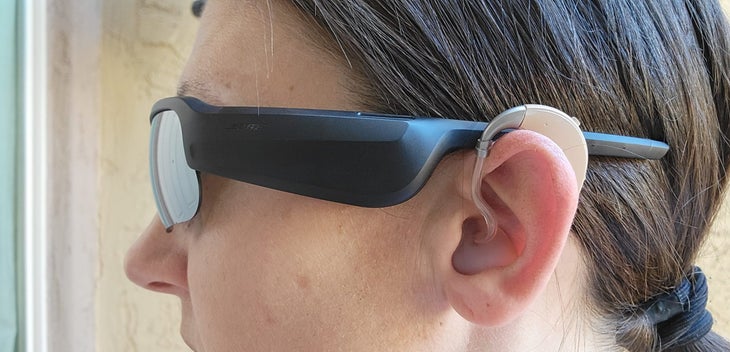New perk! Get after it with local recommendations just for you. Discover nearby events, routes out your door, and hidden gems when you sign up for the Local Running Drop.
For as long as I’ve been a runner and triathlete, I’ve envied the people who can run with music—first, with sport headphones, then with earbuds. I had always wanted to do the same, but there’s one major problem: I’m deaf and rely on hearing aids. You might think I can’t enjoy music, but I can and do—a lot. Just not while running.
When people ask me how deaf and hard-of-hearing folks listen to music, the answer is obvious: really, really loudly. But when it comes to headphones, volume isn’t the only consideration. I have to find a pair that encases the entire ear. If any part of the headphone presses on my hearing aid, it causes feedback from the microphone. You know that screeching sound a mic makes when you get too close? Try getting it directly in your ear! It’s uncomfortable, to say the least. Most over-the-ear headphones are fine for listening to music while at a desk or on an airplane, but they aren’t made for running. I’ve tried with several pairs, but they always bounce and jostle on top of the microphone of my hearing aid, interspersing my music with feedback.
In recent years, headphones have come out with versions that bypass the ear and instead use bone conduction technology to transmit the sound via vibrations to the inner ear, but that doesn’t work for me, either. My deafness is sensorineural, meaning there is damage to the nerve pathways that lead from the inner ear to the brain. It’s the most common type of hearing impairment, affecting roughly 9 out of 10 people with hearing loss.
All of this is to say: This deaf triathlete never thought she’d be writing a review of running headphones, but this deaf triathlete also never imagined there would be something like the Bose Frames Tempo Audio Sunglasses, either. For the first time, there’s a viable option for some people with hearing aids to listen to music while running. That may not have been the intention behind the making of the product, but it’s a pretty exciting bonus.
RELATED: What do Deaf Triathletes Do With Their Hearing Aids?

Bose Frames Tempo Audio Sunglasses: The Basics
These audio sunglasses from Bose is a pair of sport headphones that don’t actually go in or over your ears. Instead, the temples of the sunglasses contain integrated “micro-speakers” that direct a stream of sound right to the ears. This offers a lot of advantages to the person wearing them. The ears are open to sounds from the surrounding environment, making for significantly safer running or cycling. The targeted speakers also allow for discretion, should you not want to share your murder podcast and/or Bette Midler playlist with the world.
The audio source is transmitted wirelessly via Bluetooth in the Bose Music smartphone app, which is downloadable through both iPhone App Store and Google Play. This lets the glasses sync with and stream audio from a phone call, navigational apps, music streaming services, and more. This does mean you must run or bike with your phone, as the sunglasses do not store music locally.
Bose Frames Tempo Audio Sunglasses: The Good
When you have limited hearing like mine, you want the music you’re streaming to be crystal clear. The Tempos do well with this: the tiny speakers pack a powerful punch without sacrificing quality. There is also a microphone for taking calls or using virtual assistants like Siri or Google Assistant, and it picks up the wearer’s voice with surprising clarity, even when running.
Because Bose is an audio company, I was expecting a set of really good speakers on really crappy sunglasses. I was pleased to discover that wasn’t the case. The polycarbonate mirrored polarized lenses are high-quality and performed well on super-sunny days in Arizona. (Interchangeable blue, orange, and yellow options for the frames are also available for an additional $40 apiece.) The glasses come with three options for nose pieces, along with a tutorial in the app to help adjust your glasses for the best fit.
The glasses can be controlled via the app or on the frames themselves: Press a button on the right temple to play or pause audio, double-press to skip to the next song, and swipe along the speaker on the right temple to increase or decrease the volume. There are also built-in features for answering, ending, and declining calls. It’s intuitive and without fuss, which makes it much easier to use mid-run than swiping through a phone or smart watch.
Bose Frames Tempo Audio Sunglasses: The Lukewarm
The thing that makes these headphones so compatible with hearing aids might also be the thing that dissuades some hearing people from wearing them: Because they’re open and located on the outside of the ear, the user can still hear ambient noise, like cars, wind, or other people. If you’re looking to block out these sounds, then earbuds would be the way to go (with the caveat that this comes with certain obvious safety concerns when riding and running).
This particular sunglasses style from Bose is designed for activity, so features like flexible temple grips and spring-loaded hinges are designed to banish bouncing—perhaps a bit too well. After about 60 minutes of running, the pressure on the head becomes uncomfortable. They’re also a little bulkier (though at 1.76 ounces, not much heavier) than a typical pair of sport sunglasses.
If pairing the sunglasses with one device, then the user experience is seamless. However, when paired with a third device—a smart watch, in my case—things get clunky. Bose advertises that up to eight devices can be paired with the sunglasses; in the fine print, it clarifies this is not a simultaneous connection. If you want to switch between devices, you have to power off the frames and reconnect.
Bose Frames Tempo Audio Sunglasses: Bottom Line
There will be some who see the $250 price tag and experience a certain degree of sticker shock. It’s a lot of money, especially when quality running sunglasses can be found for as low as $20 and earbuds are handed out for free on airplanes.
If the product was attached to another company, I would have a hard time justifying the cost. But as someone with hearing loss, I need all the clarity I can get. I know I can hear more of the intricacies of a song on a Bose than on other audio setups I’ve tested in my lifetime. That, coupled with the novelty of actually being able to listen to music while I run, make this a worthy investment for me.
